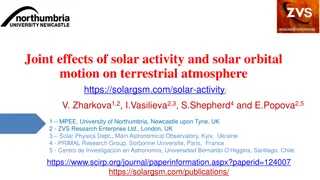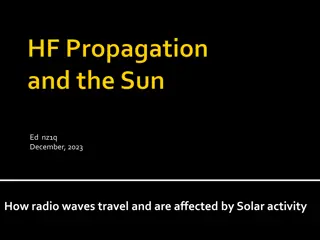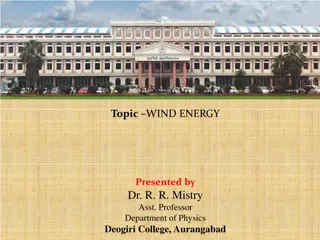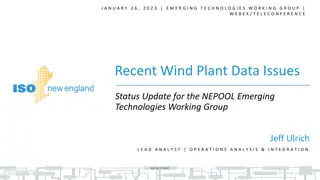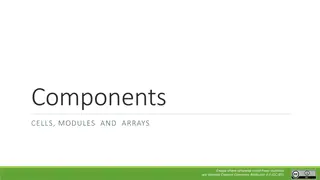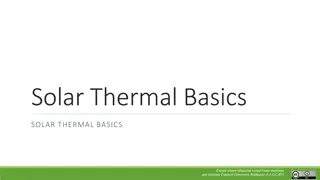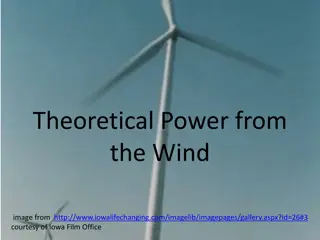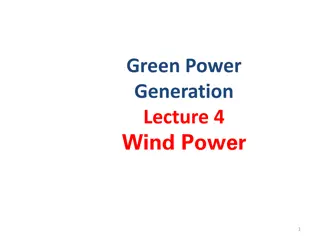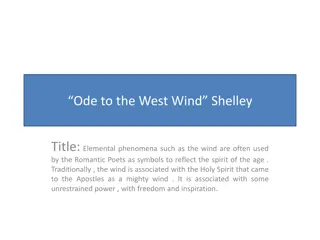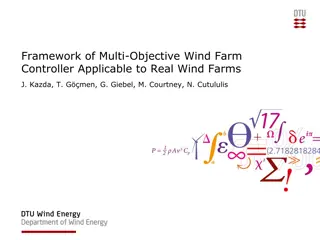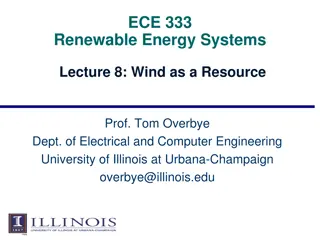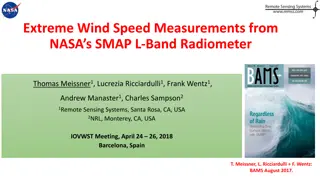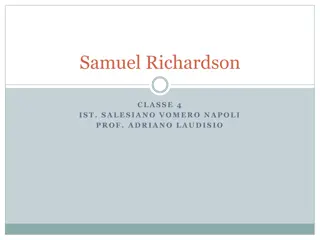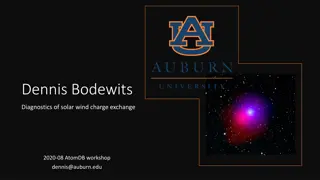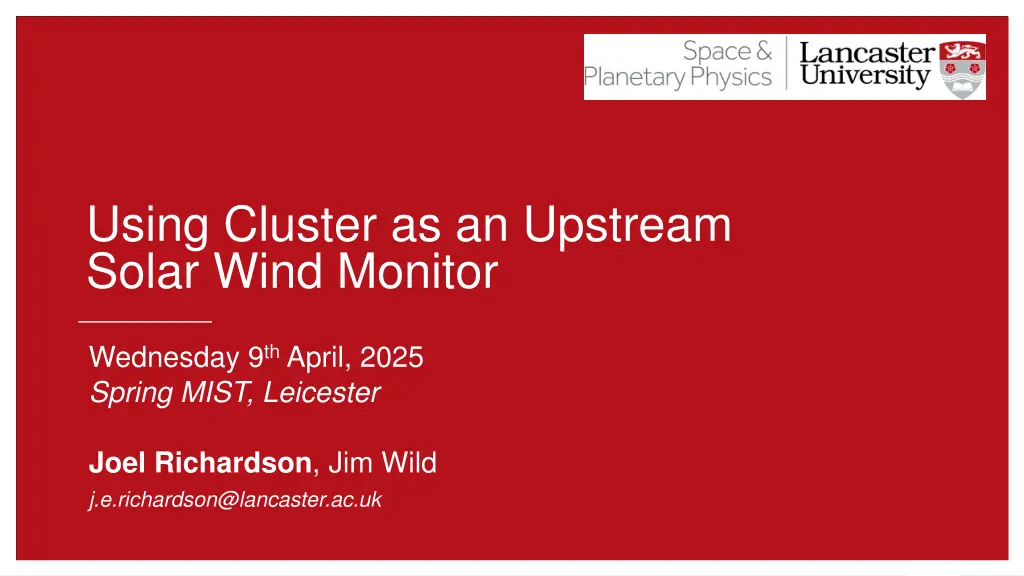
Solar Wind Monitoring Using Cluster - Research Summary
"Explore the research work of J.E. Richardson at Lancaster University, focusing on utilizing Cluster data for solar wind monitoring. The study covers data analysis, comparisons with OMNI data, and validation processes, providing valuable insights into solar wind behavior and prediction accuracy. Discover the innovative techniques and findings in this cutting-edge research project."
Download Presentation

Please find below an Image/Link to download the presentation.
The content on the website is provided AS IS for your information and personal use only. It may not be sold, licensed, or shared on other websites without obtaining consent from the author. If you encounter any issues during the download, it is possible that the publisher has removed the file from their server.
You are allowed to download the files provided on this website for personal or commercial use, subject to the condition that they are used lawfully. All files are the property of their respective owners.
The content on the website is provided AS IS for your information and personal use only. It may not be sold, licensed, or shared on other websites without obtaining consent from the author.
E N D
Presentation Transcript
j.e.richardson@lancaster.ac.uk Using Cluster as an Upstream Solar Wind Monitor Wednesday 9thApril, 2025 Spring MIST, Leicester Joel Richardson, Jim Wild j.e.richardson@lancaster.ac.uk 1 | 27
j.e.richardson@lancaster.ac.uk My Initial PhD Work 2 | 27
Overview j.e.richardson@lancaster.ac.uk Cluster active 2001 2024 Create a solar wind dataset to compare with OMNI OMNI: L1 to bow shock nose and averaged over 1-minute [1] C1: 5VPS data averaged over 1-minute (? 300 points) [2] Use Cluster B-field data only Data from Cluster-1 (Rumba) Credit: ESA 3 | 27 [1] King and Papitashvili (2005), JGR: Space Physics. [2] Laakso et al. (2010), Springer.
Cluster j.e.richardson@lancaster.ac.uk Typical BS 10,113,475 minutes (~19 yrs) ? = ?2+ ?2 vs ? in GSE Filter when Cluster is outside the bow shock: ??1> ??? Solar wind dataset Using Jel nek et al. (2012) empirical bow shock model [3] Cluster 4 | 27 [3] Jel nek et al. (2012), JGR: Space Physics.
Cluster j.e.richardson@lancaster.ac.uk 10,113,475 minutes Filter for ??1> ??? 1/? 2??? rC1 ???= cos ?+ cos2?+?2sin2? ?,?,?: from least-squares [3] ?: angle from ? axis ??: bulk flow pressure ??? calculated at each minute rBS ? 5 | 27 [3] Jel nek et al. (2012), JGR: Space Physics.
Cluster j.e.richardson@lancaster.ac.uk Contemporaneous C1 and OMNI data 7,780,451 minutes Filter for ??1> ??? 1/? 2??? ???= rC1 cos ?+ cos2?+?2sin2? ?,?,?: from least-squares [3] ?: angle from ? axis ??: bulk flow pressure Prediction from OMNI Doesn t rely on C1 plasma data rBS ? 6 | 27 [3] Jel nek et al. (2012), JGR: Space Physics.
Cluster Outside Bow Shock j.e.richardson@lancaster.ac.uk 1,400,401 minutes Filtered for ??1> ??? to obtain a solar wind dataset Compare ? with OMNI prediction to validate process ? 7 | 27 [3] Jel nek et al. (2012), JGR: Space Physics.
Cluster Outside Bow Shock j.e.richardson@lancaster.ac.uk BMSH C1 = OMNI 8 | 27
Contamination from Magnetosheath? j.e.richardson@lancaster.ac.uk Quantify potential contamination with Kobel & Fl ckiger (1994) analytical model [4]: Prediction of ?MSH from ?IMF 8.8% (123,491 minutes) above Not using to remove any data; only to describe data quality Problem with OMNI and/or bow shock model? Underestimating the bow shock 9 | 27 [4] Kobel & Fl ckiger (1994), JGR: Space Physics.
Contamination from Magnetosheath? j.e.richardson@lancaster.ac.uk ?C1 ?OMNI vs. ?C1 ?BS C1 OMNI Close to BS 10 | 27 [4] Kobel & Fl ckiger (1994), JGR: Space Physics.
Contamination j.e.richardson@lancaster.ac.uk Cropped for clarity. 11 | 27
Cluster 4 RE Buffer j.e.richardson@lancaster.ac.uk Filter for ??1> ???+ 4 RE Compromise between quantity and potential contamination: 0.15% (650 minutes) above MSH prediction Dataset of 420,694 minutes in the solar wind 12 | 27
j.e.richardson@lancaster.ac.uk Grison et al. (2025) Database 13 | 27
Geospace Region and Magnetospheric Boundary identification (GRMB) j.e.richardson@lancaster.ac.uk GRMB database classifies location for each spacecraft [5] Assigns one of 15 labels to designate the region Manual selection by operators browsing Cluster products Index 10 11 12 13 Label OUT/MSH OUT/BSTR OUT/SWF OUT/UKN Name Magnetosheath Bow Shock Transition Region Solar Wind and Foreshock Outside the magnetosphere, unknown region Minutes 1,608,156 269,413 1,535,997 20,703 14 | 27 [5] Grison et al. (2025), Nature.
Geospace Region and Magnetospheric Boundary identification (GRMB) j.e.richardson@lancaster.ac.uk Authors recommend for studying solar wind: 1) Use Region 12 data 2) Include Region 11 (& Region 13) data and apply boundary criteria Index 10 11 12 13 Label OUT/MSH OUT/BSTR OUT/SWF OUT/UKN Name Magnetosheath Bow Shock Transition Region Solar Wind and Foreshock Outside the magnetosphere, unknown region Minutes 1,608,156 269,413 1,535,997 20,703 15 | 27 [5] Grison et al. (2025), Nature.
(1) Region 12 OUT/SWF j.e.richardson@lancaster.ac.uk Start with 1,535,997 minutes Good agreement, as expected Some potential contamination: 0.21% (2,514 / 1,210,743 mins) above MSH prediction 19 days with at least 20 minutes of bad data Perform manual inspection to remove erroneous data 16 | 27
(1) Example Day: 2001-04-04 j.e.richardson@lancaster.ac.uk 17 | 27
(1) Example Day: 2001-04-04 j.e.richardson@lancaster.ac.uk 20.16 0.25 nT 7.38 0.12 nT 18 | 27
(1) Region 12 Analysis j.e.richardson@lancaster.ac.uk Similar manual inspection of all days Removed 4,559 minutes of SWF data Index 10 11 12 13 Label OUT/MSH OUT/BSTR OUT/SWF OUT/UKN Initial Minutes 1,608,156 269,413 1,535,997 20,703 Region 12 Analysis +1,942 +2,617 -4,559 - Region 11/13 Analysis - -1,137 +8,520 -7,383 Final Minutes 1,610,098 270,893 1,539,958 13,320 19 | 27
(2) Regions 11 & 13 - OUT/BSTR & /UKN j.e.richardson@lancaster.ac.uk Start with 292,733 minutes Lots of MSH data, as expected: 44.74% (101,431 / 226,734 mins) above MSH prediction Ideally would perform a manual inspection Instead use buffered bow shock, as before Add reduced data to dataset 20 | 27
(2) Regions 11 & 13 Analysis j.e.richardson@lancaster.ac.uk Used 4 RE buffered Jel nek bow shock to filter Added 8,520 minutes of BSTR & UKN data Index 10 11 12 13 Label OUT/MSH OUT/BSTR OUT/SWF OUT/UKN Initial Minutes 1,608,156 269,413 1,535,997 20,703 Region 12 Analysis +1,942 +2,617 -4,559 - Region 11/13 Analysis - -1,137 +8,520 -7,383 Final Minutes 1,610,098 270,893 1,539,958 13,320 21 | 27
Cluster Clean GRMB j.e.richardson@lancaster.ac.uk Started with 1,535,997 minutes Removed bad SWF data Added good BSTR data Results in 1,539,958 minutes of solar wind data Still contains potential contamination: 0.16% (1,902 / 1,215,579 mins) above MSH prediction Compare with buffered Jel nek bow shock dataset 22 | 27
j.e.richardson@lancaster.ac.uk Comparing Cluster Datasets 23 | 27
Comparing Datasets j.e.richardson@lancaster.ac.uk Jel nek Bow shock GRMB Database Bow shock with median ? and ? Bow shock more compressed 24 | 27
Comparing Datasets j.e.richardson@lancaster.ac.uk 25 | 27
Comparing Datasets j.e.richardson@lancaster.ac.uk 26 | 27
Conclusions j.e.richardson@lancaster.ac.uk Filtered Cluster-1 to be in the solar wind: Used a buffered Jel nek bow shock Used modified Grison GRMB database Both datasets show a similar distribution: Jel nek dataset more spread and more biased towards higher ? than GRMB Both agree with OMNI for typical solar wind conditions Next steps: Refine datasets and methods Investigate dip in Cluster data Finish writing up results into a paper Use dataset in solar wind studies Thank you! 27 | 27
References j.e.richardson@lancaster.ac.uk 1) King and Papitashvili (2005), JGR: Space Physics. 2) Laakso et al. (2010), Springer. 3) Jel nek et al. (2012), JGR: Space Physics. 4) Kobel & Fl ckiger (1994), JGR: Space Physics. 5) Grison et al. (2025), Nature. Cluster Science Archive OMNIWeb 28 | 27
j.e.richardson@lancaster.ac.uk 29 | 27
j.e.richardson@lancaster.ac.uk Extra Slides 30 | 27
Contents j.e.richardson@lancaster.ac.uk Jel nek Bow Shock Aberrated GSE Kobel Model Minimum Contamination Buffer GIF for OUT/BSTR and OUT/UKN Cluster and OMNI Yearly Histogram Comparing Both Datasets |B| Comparing Jelinek and OMNI Comparing GRMB and OMNI 31 | 27
Jelnek Bow Shock Model j.e.richardson@lancaster.ac.uk 32 | 27
Formisano (1979) Aberrated GSE j.e.richardson@lancaster.ac.uk ? 1/? 2??? ???= cos? + cos2? + ?2sin2? 33 | 27 [I] Formisano (1979), Planetary and Space Science.
Kobel and Flckiger (1994) - ?MSH j.e.richardson@lancaster.ac.uk ? ? Shue (1997) Jel nek (2012) 34 | 27 [II] Kobel & Fl ckiger (1994), JGR: Space Physics. [III] Shue et al. (1997), JGR: Space Physics. [IV] Jel nek et al. (2012), JGR: Space Physics.
Contamination Minimum j.e.richardson@lancaster.ac.uk 35 | 27
Filtering OUT/BST & OUT/UKN j.e.richardson@lancaster.ac.uk ? 36 | 27
Comparing Datasets j.e.richardson@lancaster.ac.uk OMNI All Cluster Data Van Allen Belt crossings Figure 15 37 | 27
Comparing Datasets - ? j.e.richardson@lancaster.ac.uk Fitted with log-normal distributions; Q-Q plot to compare Overall distributions similar; Jel nek more spread than GRMB Percentiles/deciles below ? = ? line Figure 16 38 | 27
Comparing Datasets with OMNI - ? j.e.richardson@lancaster.ac.uk Jel nek dataset distribution mostly agrees with OMNI Positions of peaks also agree within error Up to 99th percentile close to ? = ? line; at 100th, Jel nek >> OMNI Figure 17 39 | 27
Comparing Datasets with OMNI - ? j.e.richardson@lancaster.ac.uk GRMB dataset distribution mostly agrees with OMNI Positions of peaks don t agree within error Up to 99th percentile close to ? = ? line; at 100th, GRMB >> OMNI Figure 18 40 | 27
j.e.richardson@lancaster.ac.uk 41 | 27

